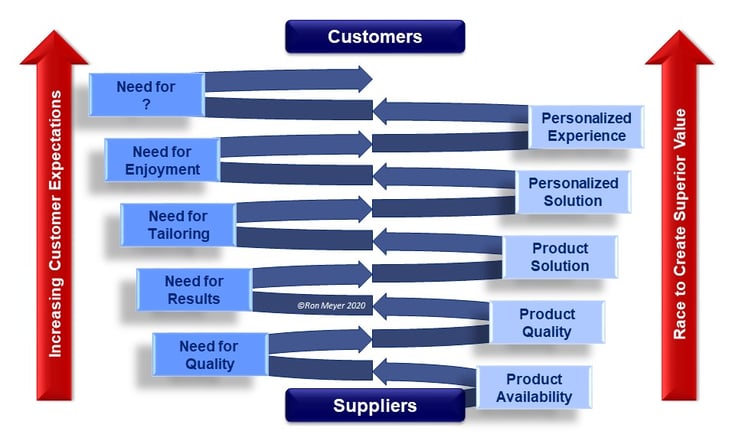How is competition evolving in my industry and how can I respond to it?

Except in monopolies, firms must compete with rivals to win the favor of potential customers. Firms can outdo others by being cheaper, better and / or different, but none of these competitive advantages are sustainable, as challengers will strive to catch up.
This process of continuous competition drives industry evolution and can feel like rushing up the down escalator – running to stand still – as firms must constantly improve the value they offer, just to stay in the race.
Conceptual model
The Competition Tornado illustrates the stormy dynamics powering the evolution of most industries. The model suggests that competitive advantage starts when a firm is the first to introduce a new product or service to the market, but that subsequent competitive advantages are found by getting closer and closer to the customer and fulfilling their specific needs. In other words, early industry evolution is prompted by product innovation (typically technology driven), while later stage evolution is spurred by value innovation (typically customer-centric).
While customers might initially be excited about new value proposition features, these are soon taken for granted and incorporated into what customers normally expect, triggering firms to explore the next level of unmet needs. For firms the challenge of moving to a next phase of evolution is not only that they must better understand customer value perceptions, but also that the underlying business model and organizational system will probably need to change. Note that at any moment a disruptive product innovation can reboot industry evolution, letting it start all over again from product availability.
Key elements
In the model there are five generic levels of value creation at which the competitive game can be played. Their order is not always the same in each industry, and in some cases extra levels are possible (hence the “?” that has been added). The five levels are:
- Product Availability. When a new type of product or service is initially launched, just having it on offer will be enough to satisfy customers. Such a sellers’ market can persist over time if there are barriers to entry restricting firms from joining the competitive game, such as patents (e.g. prescription drugs), licenses (e.g. air travel), scarce resources (e.g. rare metal mining) or economies-of-scale (e.g. large airplanes).
- Product Quality. Once multiple competitors have entered a product category, firms will typically strive to create superior customer value by having the best product or service in a particular price category. Such excellent quality in the eyes of customers can be achieved by e.g. adding features, improving durability, enhancing the design, increasing the ease of use, decreasing maintenance and/or making the product or service more luxurious.
- Product Solution. Once various competitors all offer more than acceptable quality, firms will typically shift their value creation from giving customers the inputs (products) they want to giving them the outputs (results) they need. So, instead of leasing a car they will offer mobility solutions. Such value propositions will include ‘envelop attributes’ around the core product / service, such as financing, insurance, delivery, installation and service.
- Personalized Solution. Firms can subsequently go a step further in value creation by tailoring their solution package to the specific results needed by each individual served. This requires firms to get even closer to the customer, understanding their specific requirements and basically segmenting them into markets of one, while at the same time ensuring that the cost of customization is lower than the extra value added.
- Personalized Experience. Once the value proposition being offered has been entirely optimized, firms will typically shift their focus from creating value at the moment of exchange / sale to creating value throughout the customer journey. Firms will seek to make the entire experience enjoyable, from first point of contact, through orientation, purchase, use and completion / disposal.
Key insights
- Five types of customer value creation. There are five generic competitive games that can be played, each focusing on a different type of customer value creation – the availability, quality, solution, personalization and experience games.
- Industry evolution follows the five types. As rivals race to create superior value and customers increase their expectations, a vicious cycle is triggered – the competition tornado. This industry evolution dynamic generally follows the five types in order, as levels.
- Each next level requires more customer-centricity. The lowest level of customer value creation is still very supplier-centric, but each next level requires more customer-centric thinking and behavior, which firms generally find hard to pull off.
- Each next level requires more value innovation. At the lowest level of customer value creation competitive advantage is built by (technology-driven) product innovation, but at each next level it increasingly becomes a matter of (customer-oriented) value innovation.
- Each next level requires business and organizational change. Moving between levels is hard as it requires adaptation of the firm’s business model and organizational system.
This blog is part of a series, if you want to see all the blogs, then click below:




